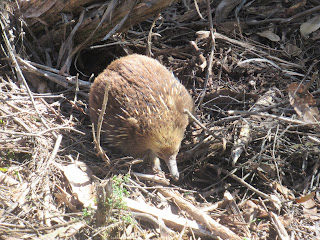The Tarkine
Our first stop of the day was at the Trowutta Arch. It is associated with a cenote, a type of sinkhole found in Mexico. The sinkhole has since been choked with debris and forms a large pond. Some of the area is limestone which has suffered erosion to form caves. Then the overlying strata has been eroded to leave a rock arch.A view through the rock arch to the large pond.
A view from the pond back through the rock arch.
The shell of a cicada, one of those noisy insects that may only come out into the open every 17 years, depending on the species.
The Sinkhole, another chocked sinkhole filled with water. There were lot of frogs making a tremenous racket. They are only small and are hard to see. They seem to have a sixth sense so that when you are looking in the direction that the noise came from, they go quiet and you can't see them.
We paused at Chisholm Lake, a large sinkhole filled with water. Some of the trees here are large.
The walk from the car park to the lake is littered with interesting flora, such a these bracket fungi on a piece of rotting branch.
We had our first glimpse of the lake.
As we had descended to the shore, we had seem ripples moving away from a central point. We had no idea of what caused them but we all hoped that it was a platypus. We stayed quiet and immobile for a long time hoping to see a platypus but to no avail.
We got back into the minibus but in no time after leaving Lake Chisholm, we spotted an echidna at the side of the road. It was the size of a hedgehog and it was rumaging in the leaf litter at the side of the road. As we approached, it turned and buried its face under a branch. We stood still and quiet. After a long wait, it felt safe enough to emerge. They are incredible creatures with mny unusual characteristics, typical of many Australian animals. It has pines ans can curl up into a ball like a hedgehog. It can also suck itself so strongly to the ground that despite its low weight, a predator can't roll it over to attack its less well protected undersides.
It has poor eyesight but we stood close by and stayed quiet. Eventually, it felt no threat and retured to the open to rumage in the leaf litter. Standing still and quiet, we got some very good close up pictures.
It has poor eyesight but we stood close by and stayed quiet. Eventually, it felt no threat and retured to the open to rumage in the leaf litter. Standing still and quiet, we got some very good close up pictures.
From Trowutta Arch to the sea, it was a very scenic journey through the sub temperate forested hills along winding, narrow roads. Up to luchtime we saw just one logging truck and two cars. Otherwise, it was deserted. We saw a Wedged tailed Eagle circuling high above the forest canopy. It is the largest bird of prey in Australia with a wing span of 2.5 metres.
We saw several Bennett's Wallabies bouncing across the road in front of us.
A family of Turbochucks scurried across the road in front of us. A family typically consists of a female, offspring, a dominant male and a subservient male. When the family are threatened by a predator, the dominant male will lead the predator away and sacrifice himself to ensure that his genes and offspring survive. The previous subservient male takes over and will tolerate another male joining the family group.
Then it was a stop for lunch at a picnic stop by the Julius River. A walk through the sub temperate rain forest was soon over. I did take a photo of a slow growing fern that had attached itself and had been incorporated into the trunk of the tree. It is not a simbyotic relationship, it is just comfortable co-existence. There had been a lot of examples of similair relationships on the trail to Trowutta Arh. I had initially thought that it was just a coincidence. It happens here as there is less competition for resources. In warmer rain forests, the competetion is so intense that competition results in outcompeting. Here, everything is slower, there are nutirents in abundence so trees can coexist and be in the same space.
The Edge of the World near the mouth of the Arthur River. It is neither the most western point of Tasmania nor the end of the world as when it was discovered, sea farers knew thw world was round and that the coasts of the major land masses had been surveyed and extensively mapped.
Loads of wood washed up. Tis is the Roaring 40's, nothing between Tasmania and Argentinia

















No comments:
Post a Comment